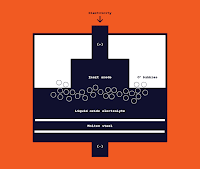Boston Metal has developed technology to electrify steelmaking, and a pending funding round will kick-start a large demonstration project.
A lumpy disc of dark-gray steel covers a bench in the lab space of Boston Metal, an MIT spinout located a half-hour north of its namesake city.
It’s the company’s first batch of the high-strength alloy, created using a novel approach to metal processing. Instead of the blast furnace employed in steelmaking for centuries, Boston Metal has developed something closer to a battery. Specifically, it’s what’s known as an electrolytic cell, which uses electricity—rather than carbon—to process raw iron ore.
If the technology works at scale as cheaply as the founders hope, it could offer a clear path to cutting greenhouse-gas emissions from one of the hardest-to-clean sectors of the global economy, and the single biggest industrial source of climate pollution.
After working on the idea for the last six years, the nine-person company is shifting into its next phase. If it closes a pending funding round, the startup plans to build a large demonstration facility and develop an industrial-scale cell for steel production.
Read more at A New Way to Make Steel Could Cut 5% of CO2 Emissions at a Stroke

No comments:
Post a Comment